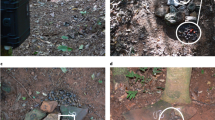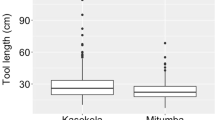Abstract
Innovations of behavior have major implications for the concept of culture in animals. Innovation has rarefy been documented in wild animal populations. The chimpanzees of the Taï National Park, Côte d’Ivoire, spontaneously included new patterns of behavior in their repertoire during our study. Some innovations were incorporated into a minority of the group members’ repertoire, whereas others, such as building day nests in trees and on the ground more frequently, became general behaviors. Similarly, new contexts for use of leaf- clipping behavior and novel ways of feeding on some leaves appeared and rapidly became part of the behavior of most group members. The environmental parameters were too stable to explain these new forms of behavior, as most of them took place within 1 month during the same dry season. In a similar way, leaf- grooming acquired a new function in Gombe chimpanzees. A process similar to social conventions could explain the emergence of these new functions for an existing behavior in a way rather similar to human “fashion. ” Three major characteristics of human culture — the absence of individual variations in the performance of the behavior, the general use of the behavior by group members, and the ability to modify the function of a behavior — characterize leaf-clipping in Taï chimpanzees and leaf- grooming in Gombe chimpanzees.
Similar content being viewed by others
References
Beck, B. (1980).Animal Tool Behavior, Garland Press, New York.
Boesch, C. (1991). Teaching in wild chimpanzees.Anim. Behav. 41(3): 530–532.
Boesch, C. (1991). The effect of leopard predation on grouping patterns in forest chimpanzees.Behavior 117(3–4): 220–242.
Boesch, C. (1993). Toward a new image of culture in chimpanzees.Behav. Brain Sci. 16(3): 514–515.
Boesch, C., and Boesch, H. (1983). Optimization of nut-cracking with natural hammers by wild chimpanzees.Behavior 83: 265–286.
Boesch, C., and Boesch, H. (1989). Hunting behavior of wild chimpanzees in the Taï National Park.Am. J. Phys. Anthropol. 78: 547–573.
Boesch, C., and Boesch, H. (1990). Tool use and tool making in wild chimpanzees.Folia Primatol. 54: 86–99.
Boesch, C., Marchesi, P., Marchesi, N., Fruth, B. and Joulian, F. (1994). Is nut cracking in wild chimpanzees a cultural behavior?J. Hum. EvoL 26: 325–338.
Cheney, D., and Seyfarth, R. (1990).How Monkeys See the World- Inside the Mind of Another Species, Chicago University Press, Chicago.
Fouts, R. S., Hirsch, A. D., and Fouts, D. H. (1982). Cultural transmission of human language in a chimpanzee mother-infant relationship. In Fitzgerald, H. E., Mullins, J. A., and Gage P. (eds.),Psychobiological Perspectives, Plenum, New York, pp. 159–193.
Galef, B. (1990). Tradition in animals: Field observations and laboratory analyses. In Bekoff, M., and Jamieson, D. (eds.),Interpretation and Explanation in the Study of Animal Behavior, Westview Press, Boulder, pp. 74–95.
Goodall, J. (1973). Cultural elements in a chimpanzee community. In Menzel, E.W. (ed.),Precultural Primate Behavior, Fourth IPC Symposia Proceedings, Karger, Basel, Vol. 1, pp. 195–249.
Goodall, J. (1986).The Chimpanzees of Gombe: Patterns of Behavior, Belknap Press of Havard University Press, Cambridge, MA.
Kawai, M. (1965). Newly acquired precultural behavior of the natural troop of Japanese monkeys on Koshima islet.Primates 6: 1–30.
Kummer, H. (1971).Primate Societies: Group Techniques of Ecological Adaptation, Aldine, Chicago.
Kummer, H., and Goodall, J. (1985). Conditions of innovative behavior in primates.Phil Trans. R. Soc. Lond B 308: 203–214.
McGrew, W. (1992).Chimpanzee Material Culture: Implications for Human Evolution, Cambridge University Press, Cambridge.
McGrew, W. (1993). The intelligent use of tools: Twenty propositions. In Gibson, K., and Ingold, T. (eds.),Tools, Language and Intelligence in Human Evolution, Cambridge, Cambridge University Press, pp. 151–170.
Nishida T. (1987). Local traditions and cultural transmission. In Smuts, S. S., Cheney, D. L., Seyfarth, R. M., Wrangham, R. W., and Strusaker, T. T. (eds.),Primate Societies, University of Chicago Press, Chicago, pp. 462–474.
Sugiyama, T. (1981). Observations on the population dynamics and behavior of wild chimpanzees at Bossou, Guinea, in 1979–1980.Primates 26: 361–374.
Thorpe, W. (1956).Learning and Instinct in Animals, Methuen, London.
Tomasello, M. (1990). Cultural transmission in tool use and communicatory signalling of chimpanzees? In Parker, S., and Gibson, K. (eds.),Comparative Developmental Psychology of Language and Intelligence in Primates, Cambridge University Press, Cambridge, pp. 274–311.
Tomasello, M., Davis-Dasilva, M., Camak, L., and Bard, K. (1987). Observational learning of tool-use by young chimpanzees.J. Hum. Evol. 2: 175–183.
Tomasello, M. Kruger, A., and Ratner, H. (1993). Cultural learning.Behav. Brain Sci. 16(3): 480–510.
Tomasello, M., Savage-Rumbaugh, S., and Kruger, A. (1994). Imitation of object related actions by chimpanzees and human infant.Child Dev. (in press).
Visalberghi, E., and Fragaszy, D. (1990). Do monkeys ape? In Parker, S., and Gibson, K. (eds.),Comparative Developmental Psychology of Language and Intelligence in Primates, Cambridge, Cambridge University Press, pp. 247–273.
Whiten, A., and Ham, R. (1992). On the nature and evolution of imitation in the animal kingdom: reappraisal of a century of research. In Slater, P., Rosenblatt, J., and Beer, C. (eds.),Advances in the Study of Behavior, Academic Press, New York, pp. 239–283.
Wrangham, R., and Nishida, T. (1983). Aspilia spp. leaves: A puzzle in the feeding behavior of wild chimpanzees.Primates 24: 276–282.
Wynn, T. (1993). Layers of thinking in tool behavior. In Ingold, T., and Gibson, K. (eds.),Tools, Language and Intelligence: Evolutionary Implications, Cambridge, Cambridge University Press, pp. 389–406.
Author information
Authors and Affiliations
Rights and permissions
About this article
Cite this article
Boesch, C. Innovation in wild chimpanzees (Pan troglodytes). International Journal of Primatology 16, 1–16 (1995). https://doi.org/10.1007/BF02700150
Received:
Revised:
Accepted:
Published:
Issue Date:
DOI: https://doi.org/10.1007/BF02700150




